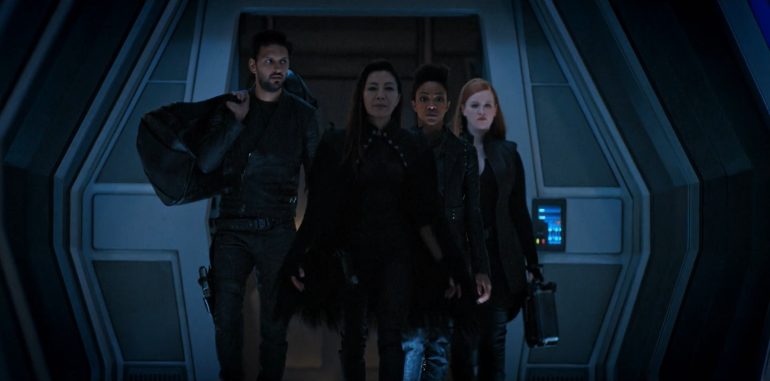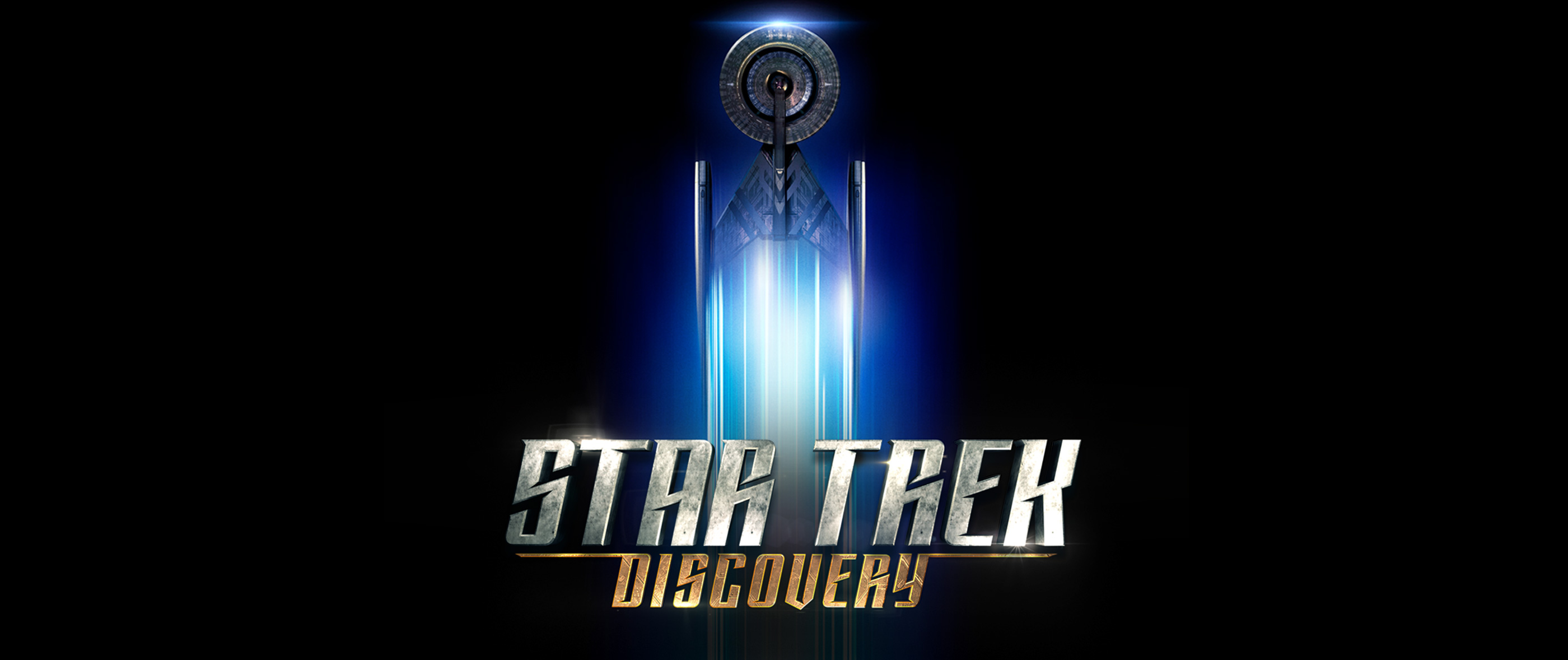
Against all odds, and despite several false starts (and some insanely odd staggers), season one of Star Trek: Discovery managed to stick the landing and wrap up most of its plot threads (as well as ending on a bit of an expected surprise…and a dose of well-needed optimism.) As always, spoilers here on out…
So when last we left the crew, they’d escaped the Mirror Universe, having killed rebel usurper Lorca (Jason Isaacs), and destroyed the emperor’s mothership, which was utilizing the mycelial network in such a way that it was threatening all life in every dimension…and had escaped with Mirror Georgieu (Michelle Yeoh), Michael Burnham (Sonequa Martin-Green) having been unwilling to let Georgieu die yet again. They returned…9 months later than planned, with the Klingons using unconventional and inconsistent methods to nearly win the war.

Now commanded by Admiral Cornwell (played by Jayne Brook, whose reaction to the destruction of Starbase 1 in the penultimate episode was…actually pretty well, considering. It was impressive feeling the actual weight of the losses through a facial reaction, much the same as the aftermath of Battle of Wolf 359 garnered a heavy response), the Discovery crew had entered a devil’s bargain: utilize Mirror Georgieu’s tactics in the current war, and strike at the Klingon homeworld, Qo’nos, by mapping strategic points by jumping to the mostly-cavernous crust of the planet. It’s the right sort of silly plan that could only be found in episodic Star Trek, and no more or less silly than some of the other schemes the franchise had played with in the past.

With this, Georgieu, Saru, Burnham, Tyler, and Tilly (of all people! Although Georgieu is more smote with her mirror counterpart, and she does have some great moments in this episode) disguise themselves as traders, adn covertly beam to the surface of Qo’nos to find the location of an ancient temple, one set at the foot of an ancient volcano, through which they will use a drone to map the entire surface. But…SWITCHEROO! It’s a trick, and Georgieu has replaced the drone with a missile, one that will detonate within the planet, erupting the very-active volcanoes on the surface, and rendering the planet inhospitable! Just like she did in the Mirror Universe! That dastardly deceiver! Who’d a thunk?!
But here the more interesting aspects come to play. Georgieu wasn’t acting alone, but under the auspices of the Federation and Starfleet. They knew EXACTLY what she was going to plan, and in their desperation (due to an incoming Klingon fleet near Earth) turned to someone whose morals and ethics can be shed when needed. We see very different approaches to not only war, but diplomacy as well: whereas Georgieu brutally attacks L’Rell in the brig to get information, Tyler, in a later scene, merely plays a gambling game and speaks Klingon to not only gain trust, but information as well. Whereas the Federation and Starfleet are willing to undermine the very merits and values they uphold so dearly in desperation, Burnham and the crew wind up trusting L’Rell to end the war, not only guaranteeing the survival of both sides, but also finally uniting the Klingons under one manner…the very thing she’d hoped to do with Voq in the beginning. The crew walks away wiser, having managed to both avoid committing genocide AND end a catastrophic war; and Tyler finds his own place trying to mend relations between the Klingons and Federation, finding he belongs to neither, so he might as well work for both.
Throughout the later (well…chronologically speaking…I guess technically they’re the earlier) iterations of Starfleet and the Federations, their ideals and philosophy is already set. Theirs is already a more perfect future, closer to the conflict-free environment Gene Roddenberry envisioned, where the Federation always followed through with its vision of right and wrong. Here (and this is the episode that best encapsulates this) that philosophy isn’t yet set; there are corners to cut, and ethics to ignore when the need arises…and most of this season has focused on the ramifications of those shortcuts (even from the Klingon perspective: in a rush to unite the Klingons, T’Kuvma and Voq inadvertently worsened tensions, further divided the houses, and Voq himself took a shortcut to martyrdom by merging with Tyler…to catastrophic effect for both of them). And it’s a fascinating divergence from what we have before seen in Star Trek. Here, the conflict is resolved (in a very Star Trek-ian manner) with an uneasy, yet solid, trust between the Klingons and Federation (as well as allowing Mirror Georgieu to escape…wonder if SHE’LL be back?!), and one in which we see Federation ideals enacted in real-time, rather than talked about prosaically.

Finally…it’s great to finally see a dirtier, more complicated vision of Star Trek. As I stated in an earlier review, Star Trek is nothing if not a topical commentary, and here that is thrown full-front as well (it is hard to miss the allegory of the different Klingon houses fighting with very different tactics, sometimes with suicide missions, and in-fighting, with no central leadership and the most tenuous of philosophies; as well as the Federation’s desperation to survive by undermining its own ideals out of convenience and fear). If any era needs a complicated Star Trek, one that shows the trials and tribulations and hardships and veiled optimism during turbulent times…it’s exactly the one we’re in right now. The mission on Qo’nos itself gave further hints at the more complicated landscape that I hope gets further explored in later seasons: the away team disguise themselves as human traders, entirely independent of Starfleet AND the Federation, finally giving a much needed diversity to Earth culture (as had happened with the Vulcans…as well as the Klingons), and varying instances of diversity among the green-skinned Orions (oh yeah…they show up in multitude here…as does Clint Howard, of all people!). It’s these little flourishes and details that sometimes go in passing that added a richness that the other series in the franchise (save the latter half of Deep Space Nine) often overlooked.
With Burnham’s rousing speech about the Federation ideals, and what makes it great, the Discovery is off to meet its new captain…before intercepting a distress signal. And we get a familiar registry number…and a slightly redesigned look at a familiar ship.

It was an infuriating start at times, but Discovery has me in for Season 2. Let’s get a better look at the rest of the bridge crew, eh?! What’s up with that android lady?!
(Note: Those harping on the design of the Discovery and the Constitution-class ships in this show – study the making of the aborted Star Trek: Phase II from the mid-1970s. Both are near exact replications of the proposed design of the Enterprise for that show.)
4/5 space whale kebabs

